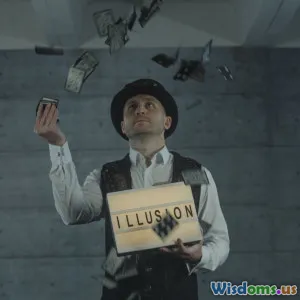
Are Levitation Illusions Really as Harmless as They Appear
8 min read Explore the hidden complexities and potential risks behind levitation illusions in magic and stage performances. (0 Reviews)
Are Levitation Illusions Really as Harmless as They Appear?
Levitation illusions have fascinated audiences for centuries, blending mystery, technology, and artistry into performances that defy gravity. Whether a magician floats effortlessly above a stage or a performer hovers mid-air in a seemingly impossible stasis, such feats enthrall and inspire wonder. Yet beneath the dazzling veneer and surprising spectacle lie questions about the safety, ethics, and deeper implications of levitation acts. Are they simply harmless entertainment, or do these illusions carry unseen risks and consequences?
The Entrancing Power of Levitation Illusions
Levitation is one of the hallmark illusions in magic, popularized by legends such as Harry Houdini and David Copperfield. The spectacle of defying gravity taps into fundamental human desires to rise above the ordinary, making the illusion especially compelling.
Historical Context and Modern Appeal
Levitation illusions date back to ancient mystical performances and religious ceremonies where mediums claimed to float, lending an aura of spiritual authority. As magic became modern entertainment, the illusion was refined with hidden supports, wires, optical illusions, and manipulating perspective.
Modern magicians use a combination of mechanical devices, invisible wires, mirrored angles, and even subtle digital enhancements to create convincing levitations. For instance, David Copperfield’s iconic "Flying" illusion involved complex harnesses and computerized rigging systems enabling him to glide smoothly over audiences, enhancing the allure without apparent mechanical aid.
Psychological Impact on Audiences
Levitation illusions exploit cognitive blind spots, favouring anticipation and misdirection. Neuroscientist Matthew L. Cohen explains, "Illusions fundamentally exploit the brain’s assumptions about physical laws and visual cues, allowing partial disbelief to be suspended." This intense suspension amplifies emotional responses such as wonder and amazement.
The Mechanics Behind the Magic
While the audience sees only floating bodies, the construction of levitation illusions relies on intricate engineering and precise control.
Wire and Harness Systems
Many levitation acts deploy ultra-fine wires made from materials like Kevlar or high-tensile steel that can support performers’ weight discreetly. Stage lighting and angles are carefully calibrated to mask these supports. Despite invisibility to spectators, these wires introduce physical strain and risk for the performers—any malfunction can result in falls from significant heights.
Hidden Platforms and Mirrors
Another classic technique involves hidden supports: ledges or platforms concealed behind props or reflections. This method is common in "balancing" levitations. For example, famed magician Jean Eugène Robert-Houdin in the 19th century used cleverly designed supports integrated into costumes and stages to lift assistants, with the illusion completed through lighting tricks.
Magnetic and Technological Innovations
In recent years, magnetism and drones have been introduced to enhance levitation performances. While magnets provide silent lifts with no visible support, the strong electromagnetic fields involved necessitate careful treatment to prevent injury. Drone-assisted levitations raise concerns about operational reliability and public safety in live shows.
Are There Hidden Dangers?
Physical Risks to Performers
Levitation illusions typically demand rigorous training and physical resilience. Missteps in harness attachment, wire tension, or platform stability can cause acute injuries, including concussions, sprains, or fractures. For instance, in 2014, a stunt gone wrong during a levitation trick in a Las Vegas show led to a broken leg and months of recovery for the performer.
Psychological Effects
Constant performances under high-risk conditions may precipitate stress and anxiety among magicians and assistants. The necessity for precise body control also increases mental strain.
Audience Safety Concerns
Public performances of levitation illusions sometimes involve audience proximity to rigging or moving mechanical parts. Without rigorous safety precautions, spectators might face hazards from equipment failure or accidental collisions.
Ethical and Cultural Reflections
Levitation illusions blur lines between real and unreal, and some contend they propagate deceptive practices harmful when applied beyond entertainment.
The Balance Between Wonder and Deception
Magic inherently involves deceit, but levitation elevates this to physical impossibility, risking fostering unrealistic beliefs if the audience is unaware it's a trick. Magician Ricky Jay noted, "Magic is a contract between performer and spectator, an agreement to be deceived for joy. When that contract is broken or misunderstood, it can generate mistrust."
Cultural Sensitivity
Historically, levitation was associated with mysticism and religious miracles. Some modern-day contexts might consider using levitation illusions insensitive or exploitative, especially where communities hold spiritual significance tied to such phenomena.
Safeguarding Levitation Illusions
Industry Standards and Training
Professional magic societies have emphasized the importance of safety measures and rigorous rehearsals. The Magic Circle in London mandates comprehensive safety protocols and encourages peers to share knowledge about harm prevention.
Transparent Communication
While magicians do not reveal their secrets, educating the public about the illusion nature of levitation could alleviate undue fears or misconceptions. Some performers include disclaimers or contextual explanations to maintain ethical boundaries.
Technological Rigor
Continuous innovation in rigging technology promises safer, more reliable levitation experiences. For example, computerized wire tension monitors alert operators to issues before accidents occur, minimizing risk.
Conclusion: Beyond the Magic
Levitation illusions remain a powerful vehicle to captivate and inspire wonder, thriving on our fascination with the impossible. Yet labeling them as "harmless" oversimplifies the complex tapestry of engineering challenges, physical risks, psychological stresses, and ethical considerations woven into their creation and performance.
By understanding the meticulous preparation, potential dangers, and cultural contexts of levitation illusions, audiences can appreciate the artistry more deeply while magicians continue developing safer, more respectful, and thrilling renditions of this timeless enchantment.
Ultimately, levitation is more than a magic trick; it is a dance between reality and imagination where care, knowledge, and respect ensure it remains an awe-inspiring spectacle without unintended harm.
References
- Lamont, P. (2014). The Psychology of Magic: An Investigation into the Effect of Cognitive Bias in Performing Illusions. Journal of Visual Cognition.
- Copperfield, D. David Copperfield's Flying Illusion (2001). CBS Broadcast.
- The Magic Circle Safety Guidelines (2020). London Magic Society Standard Documents.
- Ricky Jay Interviews. Illusions and Ethics, Documentary, 2016.
- Houdini, H. (1924). The Unmasking of Mysteries: My Life as a Magician and Skeptic.
Rate the Post
User Reviews
Popular Posts





















